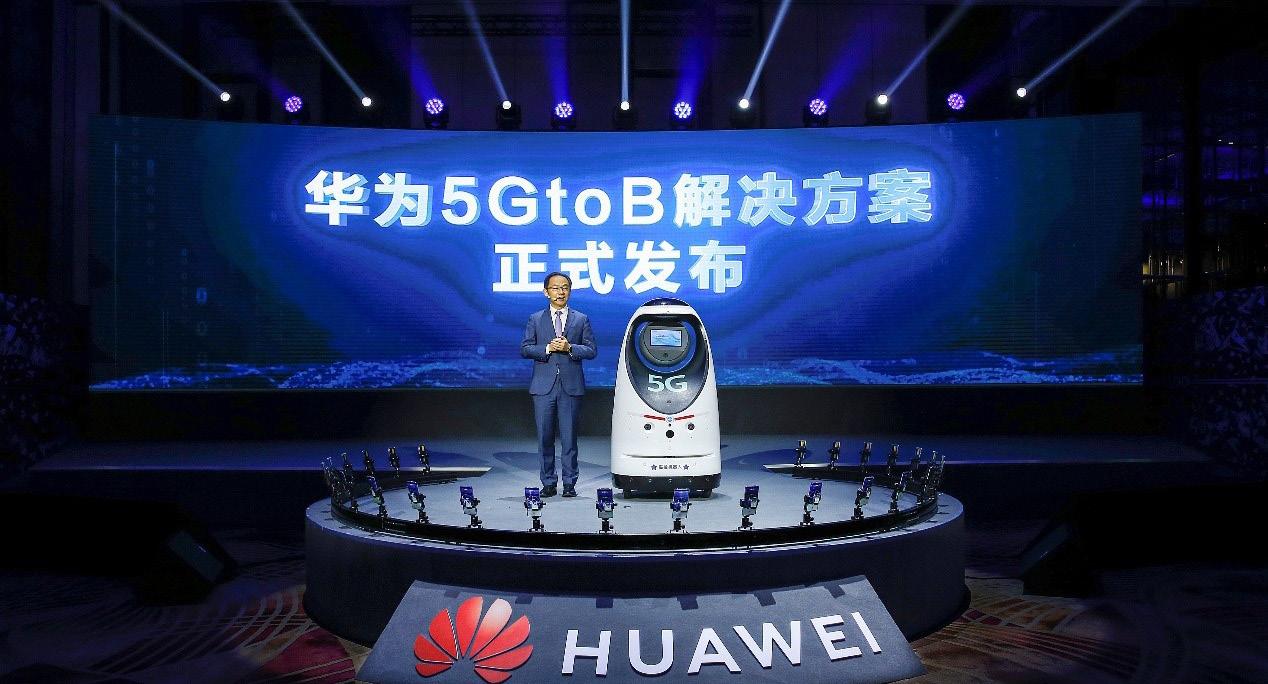
7 minute read
5G Will Create New Value Across
5G Will Create New Value Across All Industries
At the Mobile World Congress Shanghai 2021, Huawei’s Executive Director and Carrier Business Group President Ryan Ding gave a keynote speech at the company’s “5G Brings New Value” forum, where he announced the official launch of Huawei’s 5GtoB solution. This new solution is aimed at creating new value for every player across the industry value chain.
Advertisement
Ding stated that building on its experience in connectivity, computing, and industry digitalization, Huawei has worked with operators and other industry partners to develop a one-stop solution that covers sales, operations, and services – the 5GtoB solution. This solution will simplify transactions for enterprise users, help operators monetize their network capabilities, and allow partners to innovate more efficiently, creating new value for every player involved.
Ding also talked about the developments, commercial returns, and opportunities for industry digitalization that 5G would bring. The 5G industry has been developing faster than expected, with operators already seeing commercial returns from the first wave of 5G rollouts. The 5G user base and the number of 5G devices in commercial use have exploded since 2019. By the end of 2020, 380 5G devices had hit the market, 8 times more than the year before. The mobile 5G user base had also reached 220 million and wireless home broadband connections reached 1.05 million, a 17 and 21 times YoY increase, respectively. Ding claims these numbers will triple in 2021.
During the event, Ms. Jacqueline Shi, Vice President of Huawei’s Cloud & AI Business Group and President of the Cloud & AI Marketing Dept., proposed a reference architecture for telecoms carriers’ digital transformation. Speaking during the “5G Creates New Value” forum, Ms. Shi outlined a roadmap in her speech, “Taking Digital Transformation to the Next Level”, for how carriers can build a digital, intelligent infrastructure centered around full-stack data centers and clouds, and how they can take a phase-by-phase, multi-path approach towards full-scale digital transformation.
“Digital transformation helps carriers to develop ubiquitous computing capabilities, especially cloud capabilities, and aggregate ecosystem to enable industry transformation. Huawei is willing to work with carriers and partners to light up dreams of the new industry, making the most of the unique opportunities of the digital era.” Ms. Shi said.
Additionally, Dr. Tong Wen, Huawei Fellow and CTO of Huawei Wireless, delivered a keynote speech titled “Continuous 5G Evolution for Building an Engine of All-Industry Digitalization” at the 5G Advanced Summit hosted by the Global System for Mobile Communications Association (GSMA). Dr. Tong emphasized that 5G must continuously evolve to build an engine of all-industry digitalization so as to satisfy the fast-growing consumer connections and diverse industrial applications.
Also, at the event, the China Academy of Information and Communications Technology (CAICT), China Mobile Research Institute, China Unicom, China Telecom, and Huawei jointly released the 5GDN Architecture White Paper. The white paper aims to address the preceding technical deficiencies, improve the deterministic network architecture, enhance the deterministic network capabilities, and support additional service scenarios. Airbus and Atlas Telecom, a UAE-based communications technology integration and security solutions company, signed a strategic partnership agreement at the ongoing IDEX 2021 to combine their local and global expertise and reinforce collaboration among public safety agencies in Abu Dhabi.
The cooperation will lead to the integration of Airbus’ Tactilon Agnet, Everus Manpack and Tactilon Dabat into Atlas Telecom’s solutions for defense and security applications. Tactilon Agnet brings terminal radio and smart device users together, allowing real-time sharing of voice, data, video and location information. Embedded in Tactilon Agnet, the portable Everus Manpack LTE tactical bubble enables voice and video services, and gives users a direct link to the headquarters.
In the frame of the agreement, Airbus will also provide the TW1m Tetra modem, which will unlock the capabilities of Atlas Telecom’s E-passport tracking device, an advanced compact and intelligent vessel tracker.
“Atlas Telecom always emphasizes the need to provide a reliable and secure critical communication infrastructure for reinforced collaboration between security forces and personnel across sectors. Through our new partnership, we can further strengthen our capability to deliver secure and modern devices for efficient exchange of data, voice, and information,” Samer Jammoul, Managing Director of Atlas Telecom, explained.
“In the Middle East, where we have strong market presence, our collaboration with Emirati companies such as Atlas Telecom allows us to jointly deliver better products and services. It results in an engagement that brings economic benefits. This reflects our commitment to introduce technology-driven solutions to the region, especially in the UAE where we are witnessing a rapid upgrade of infrastructure and security as it bids to become a leader in the global security and safety industry,” added Selim Bouri, Vice President and Head of Region MEA & Asia Pacific of Secure Land Communications at Airbus.
Airbus and Atlas Telecom Join Forces to Offer Mission-Critical Smart Communications
Digital Transformation Pressures Drive Big Spike in Global Microservices Adoption
The sixth annual survey of NGINX’s extensive open-source user community found that the proportion of applications being built with microservices jumped from 40% to 60% in the past year. At the same time, more than 50% of the 600 respondents indicated that they were using microservices in some or all apps.
The survey also revealed that containers are twice as popular as other modern application technologies. Moreover, 34% of respondents said that they were using containers in their production environment, compared to serverless (15%) and service discovery (7%). NGINX’s research resonates with Gartner’s recent prediction that 75% of global organizations will be running containerized applications in production environments by 2022, up from less than 30% today.
“We’re seeing a big shift from monolithic to microservices-based apps. More than ever before, organisations are looking to build platforms with greater resilience and faster deployment capabilities. Without question, there’s a growing confidence worldwide that microservices-based apps can help improve the user experience, which is an increasingly critical success factor for all organisations,” said Dor Zakai, EMEA Senior Director for Solutions Engineering, NGINX at F5.
A further indication of this shift is that 14% of respondents plan to embrace service meshes in the next year, a 50% jump from the number currently doing so. As it stands, public cloud remains the most popular infrastructure option for modern app tools (55% of respondents), followed by Infrastructure-as-a-Service (23%), serverless computing (13%) and private Platform-as-a-Service (11%). Organisations are also steadily moving away from on-premises load balancers, with 24% now using software-based load balancers and 19% sticking with hardware. NGINX’s community survey responses indicate that the latter is set to drop to 15% in the next year.

Why Telcos Should Prioritize Efficiency and Sustainability in 5G Networks?
5G will be the most transformative communications technology in a generation and enable a universe of new services, including advanced energy management capabilities that will be critical to solving growing energy and sustainability challenges. But new research highlights the practical challenges of 5G energy management facing telecommunications operators.
Estimates suggest 5G networks can be up to 90% more efficient per traffic unit than their 4G predecessors, but they still require far more energy due to increased network density, heavy reliance on IT systems and infrastructure, and increased network use and accelerated traffic growth. The report from telecommunications consultancy STL Partners and Vertiv conclude telecom operators should address these challenges in two ways: By adopting energy efficiency best practices across their networks, and by encouraging their customers to adopt 5G-enabled services to reduce consumption and emissions in all walks of life.
STL Partners estimates global 5G traffic will overtake 3G/4G as soon as 2025, making sustainability an urgent priority for operators. In fact, 40% of enterprises surveyed for the report indicated energy efficiency should be the first or second priority for telecom operators when deploying 5G networks.
The report, Why Energy Management Is Critical To 5G Success, uses research including a survey of 500 enterprises globally to outline the challenges telcos face as they wrestle with the increased energy use and costs associated with 5G. The paper identifies several best practices aimed at mitigating those increases and costs, organized across five categories:
• Network Technology: Deploying hardware and software designed and operated for efficiency • Facilities infrastructure: Including new edge data centers to support cloud-native IT • Infrastructure management: Deploying the appropriate hardware and software to measure, monitor, manage, improve and automate the network • Organization and evaluation: Taking a holistic, full lifecycle view of costs and investments across the network • Working with others: Embracing innovative and non-traditional commercial models, standards and collaboration
“Telecom operators making meaningful energy and cost reductions are doing so by evaluating the entire ecosystems around their network operations – people, objectives, infrastructure, and partners,” said Scott Armul, vice president for global DC power and outside plant at Vertiv. “Because of the reliance on IT to enable 5G applications, a high degree of collaboration will be required across operators, OEMs and infrastructure providers, and customers to ensure deployments are optimized and every possible efficiency is pursued.”
“Operators are deploying 5G networks to grow new revenues. This growth will come from new connectivity and applications enabling operators’ customers’ own transformation journeys,” said Phil Laidler, director at STL Partners. “To be credible, informed partners for their customers, operators must lead by example. Energy strategy is a great place to start.”










